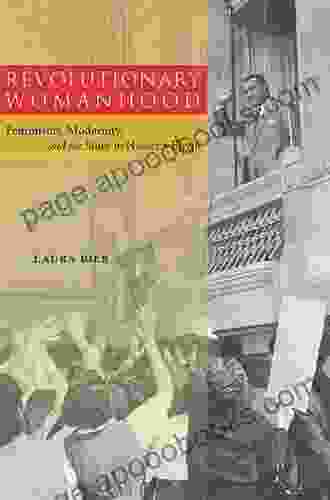Egypt's Revolutionary Situation: Stanford Studies in Middle Eastern and Islamic Societies and Cultures

The Egyptian revolution of 2011 was a watershed moment in the history of the Middle East. It began with a series of protests in January 2011, and within weeks, it had toppled the regime of President Hosni Mubarak. The revolution was sparked by a number of factors, including widespread poverty, unemployment, and corruption. It was also fueled by the rise of social media, which allowed activists to organize and mobilize support for their cause.
The Egyptian revolution had a profound impact on the region. It inspired similar uprisings in other Arab countries, and it led to the overthrow of several authoritarian regimes. It also raised questions about the future of democracy in the Middle East.
5 out of 5
| Language | : | English |
| File size | : | 8937 KB |
| Text-to-Speech | : | Enabled |
| Screen Reader | : | Supported |
| Enhanced typesetting | : | Enabled |
| Word Wise | : | Enabled |
| Print length | : | 392 pages |
This book provides a comprehensive analysis of the Egyptian revolution. It examines the causes of the uprising, the dynamics of the protest movement, and the consequences of the revolution. It offers a unique perspective on the uprising, drawing on the expertise of leading scholars in the field.
Table of Contents
- The Causes of the Revolution
- The Dynamics of the Protest Movement
- The Consequences of the Revolution
The Egyptian revolution of 2011 was a watershed moment in the history of the Middle East. It began with a series of protests in January 2011, and within weeks, it had toppled the regime of President Hosni Mubarak. The revolution was sparked by a number of factors, including widespread poverty, unemployment, and corruption. It was also fueled by the rise of social media, which allowed activists to organize and mobilize support for their cause.
The Egyptian revolution had a profound impact on the region. It inspired similar uprisings in other Arab countries, and it led to the overthrow of several authoritarian regimes. It also raised questions about the future of democracy in the Middle East.
This book provides a comprehensive analysis of the Egyptian revolution. It examines the causes of the uprising, the dynamics of the protest movement, and the consequences of the revolution. It offers a unique perspective on the uprising, drawing on the expertise of leading scholars in the field.
The Causes of the Revolution
The Egyptian revolution was caused by a number of factors, including:
- Widespread poverty
- Unemployment
- Corruption
- The rise of social media
Poverty is a major problem in Egypt. According to the World Bank, over 25% of Egyptians live below the poverty line. Unemployment is also a major issue, with over 10% of the population unemployed. Corruption is another major problem in Egypt. According to Transparency International, Egypt is ranked 114th out of 175 countries in terms of corruption.
The Dynamics of the Protest Movement
The Egyptian protest movement was a diverse and decentralized movement. It was led by a variety of groups, including youth activists, political parties, and labor unions. The movement was also fueled by the rise of social media, which allowed activists to organize and mobilize support for their cause.
The protests began in January 2011 with a series of small demonstrations in Cairo and other cities. The protests quickly grew in size and intensity, and within weeks, they had spread to all of Egypt's major cities. The protesters demanded the ouster of President Mubarak and the establishment of a democratic government.
The Consequences of the Revolution
The Egyptian revolution had a profound impact on the country. It led to the ouster of President Mubarak, the establishment of a new constitution, and the election of a new president. The revolution also raised questions about the future of democracy in the Middle East.
The Egyptian revolution is still ongoing. The country is facing a number of challenges, including economic instability, political instability, and the threat of terrorism. However, the revolution has also created a new sense of hope and possibility in Egypt. The Egyptian people are determined to build a more just and democratic society.
The Egyptian revolution of 2011 was a watershed moment in the history of the Middle East. It was a powerful expression of the desire for change in the region. The revolution had a profound impact on Egypt, and it raised important questions about the future of democracy in the Middle East.
This book provides a comprehensive analysis of the Egyptian revolution. It examines the causes of the uprising, the dynamics of the protest movement, and the consequences of the revolution. It offers a unique perspective on the uprising, drawing on the expertise of leading scholars in the field.
This book is essential reading for anyone who wants to understand the Egyptian revolution and its impact on the Middle East.
References
- The World Bank. (2012). Egypt: Poverty and Inequality. Retrieved from http://www.worldbank.org/en/country/egypt/brief/egypt-poverty-and-inequality
- The World Bank. (2012). Egypt: Unemployment. Retrieved from http://www.worldbank.org/en/country/egypt/brief/egypt-unemployment
- Transparency International. (2012). Corruption Perceptions Index 2012. Retrieved from http://www.transparency.org/cpi2012/results
5 out of 5
| Language | : | English |
| File size | : | 8937 KB |
| Text-to-Speech | : | Enabled |
| Screen Reader | : | Supported |
| Enhanced typesetting | : | Enabled |
| Word Wise | : | Enabled |
| Print length | : | 392 pages |
Do you want to contribute by writing guest posts on this blog?
Please contact us and send us a resume of previous articles that you have written.
 Book
Book Novel
Novel Page
Page Chapter
Chapter Text
Text Story
Story Genre
Genre Reader
Reader Library
Library Paperback
Paperback E-book
E-book Magazine
Magazine Newspaper
Newspaper Paragraph
Paragraph Sentence
Sentence Bookmark
Bookmark Shelf
Shelf Glossary
Glossary Bibliography
Bibliography Foreword
Foreword Preface
Preface Synopsis
Synopsis Annotation
Annotation Footnote
Footnote Manuscript
Manuscript Scroll
Scroll Codex
Codex Tome
Tome Bestseller
Bestseller Classics
Classics Library card
Library card Narrative
Narrative Biography
Biography Autobiography
Autobiography Memoir
Memoir Reference
Reference Encyclopedia
Encyclopedia Ratan Kaul
Ratan Kaul Michael Lind
Michael Lind Paulette Kouffman Sherman
Paulette Kouffman Sherman Michael Steen
Michael Steen Murray Stewart Leith
Murray Stewart Leith Tom Little
Tom Little Mati Ventrillon
Mati Ventrillon Rachel Hauck
Rachel Hauck Nancy Devlin
Nancy Devlin Nasser Hussain
Nasser Hussain Steven Salaita
Steven Salaita Valerie Muter
Valerie Muter Mike Mcleod
Mike Mcleod Rita Laws
Rita Laws Nancy Holder
Nancy Holder Sylvester Barzey
Sylvester Barzey Pavon James
Pavon James Mischa Gabowitsch
Mischa Gabowitsch Mary B Mackley
Mary B Mackley Murray Pura
Murray Pura
Light bulbAdvertise smarter! Our strategic ad space ensures maximum exposure. Reserve your spot today!

 Raymond ChandlerUnleash the Thrills: Embark on a Literary Odyssey with Michael Crichton's...
Raymond ChandlerUnleash the Thrills: Embark on a Literary Odyssey with Michael Crichton's... DeShawn PowellFollow ·14k
DeShawn PowellFollow ·14k Marcel ProustFollow ·8.8k
Marcel ProustFollow ·8.8k Bruce SnyderFollow ·2.2k
Bruce SnyderFollow ·2.2k Hudson HayesFollow ·11.8k
Hudson HayesFollow ·11.8k Chris ColemanFollow ·3.7k
Chris ColemanFollow ·3.7k Corbin PowellFollow ·7k
Corbin PowellFollow ·7k Harvey HughesFollow ·2.5k
Harvey HughesFollow ·2.5k Kelly BlairFollow ·3.6k
Kelly BlairFollow ·3.6k

 Ben Hayes
Ben HayesJourney into the Verdant Realm of "Plants vs. Zombies:...
Immerse Yourself in an Epic Battle for...

 Edward Reed
Edward ReedUnveiling the Allure of Modish Crochet Hats Annie...
In the realm of fashion and...

 Jaylen Mitchell
Jaylen MitchellHalf Moon Bay: An Unforgettable Adventure Awaits in Aj...
Prepare yourself...

 Dan Brown
Dan BrownUnleash the Plant-Powered Apocalypse: Dive into Paul...
Prepare yourself for an epic showdown where...

 Efrain Powell
Efrain PowellStolen Summer: Nora Sommer's Enthralling Caribbean...
Escape to a World of...

 Steven Hayes
Steven HayesPlants vs. Zombies: Lawnmageddon - The Ultimate Battle...
Prepare for the ultimate battle between plants...
5 out of 5
| Language | : | English |
| File size | : | 8937 KB |
| Text-to-Speech | : | Enabled |
| Screen Reader | : | Supported |
| Enhanced typesetting | : | Enabled |
| Word Wise | : | Enabled |
| Print length | : | 392 pages |










